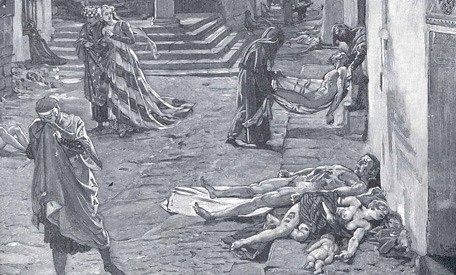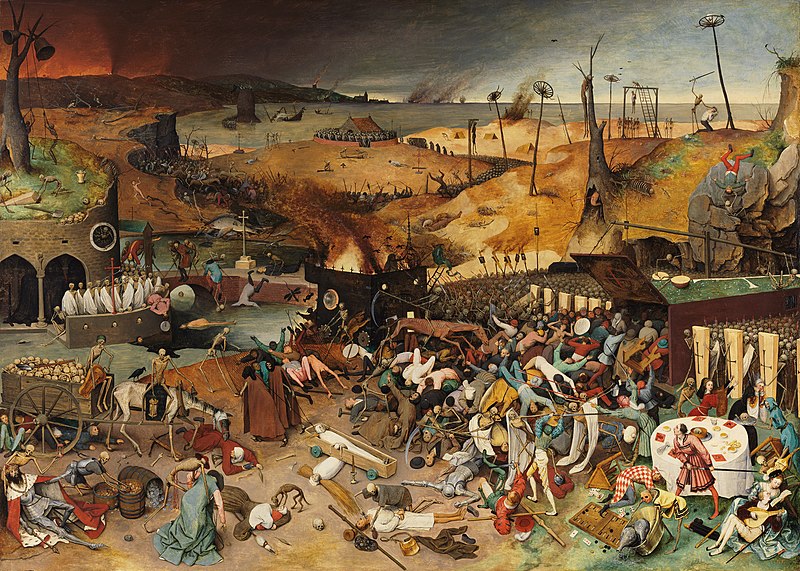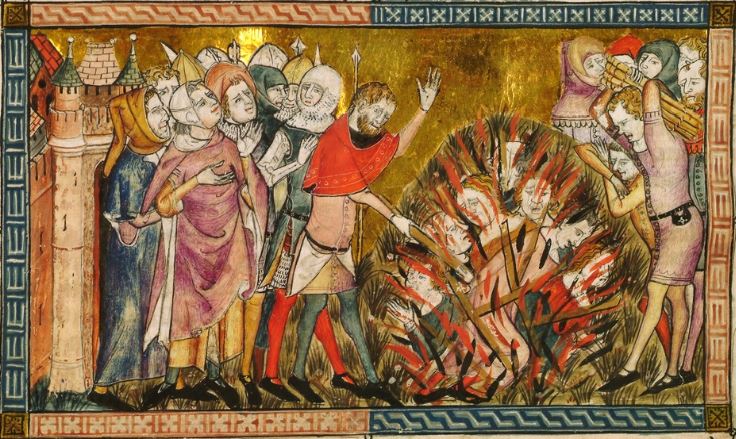The Great Mortality
The Great Mortality, Bubonic Plague, Black Plague, or just The Pestilence.... either way you slice it, your chances of living after contracting this disease are low. Feared by all and spread by the most ambiguous and uninteresting creature on the planet - fleas. The plague, some historians believe, can be traced back to the Mongol Invaders of Crimea and the surrounding lands. During a siege against he Venetians in the mid 14th century, heads infected with this mysterious disease were lobbed over the high walls of Venetian controlled Caffa. Naturally, the pestilence made them abandon the city and bring with them several unwanted and historically significant pests.
The plague devastated port cities first, spreading via the trade routes into Europe from Constantinople and Jerusalem in the east to as far west as Lisbon and Dublin. It wasn't all at once either, slowly creeping, year by year, city by city until it had rotated, in a clockwise manner, back to the east and into the central Asian steppes. Scholars and scientist estimate that the Black Death killed between 75,000,000 - 200 million people in Eurasia and North Africa. Imagine the Covid infection numbers, that currently stand at 183 million globally, turned into fatalities. That is the massive scale of death the medieval world was dealing with. Burning bodies in endless pits, burying bodies to be dug up by animals later, and losing up to 2/3 of the European population were all fearful results of this bacterial infection.
Symptoms included the blackening of extremities, large puss-filled and painful bumps/bubos caused by swelling lymph nodes, and an almost crushing feeling before drowning in your own fluids. Those were your three options if infected since there were 3 parts/versions of this horrible plague that has reoccurred in human history since the late Neolithic and early Bronze Age. Some did survive symptoms of the plague but these were only the people infected with the bubonic version of the plague. See sidebar for more details on the different kinds of plague.
Overall, this plague was devastating to populations across Europe and created an ever-looming fear of disease and sickness. During a time before hygiene or the concept of germ-theory, there seemed to be little hope for infected persons. However, what happened after the great plague, and the quick succession of scientific and academic endeavors, particularly humanism and the protestant reformation, lead to a surge in population. Workers were more highly valued and demanded better wages and living conditions and education seemed to be making a comeback since its decline during the ages after the fall of the Western Roman Empire.
At the time, people believed that the plague was an act of God but was also blamed primarily on minority communities including the local Jews, resulting in burnings and local crusades. Some believed they had cast spells and others believed that they had poisoned wells. Tens of thousands of Jews were displaced, driven out, or murdered because of the superstition and fear that arose during The Great Mortality.
Bubonic plague is fatal in about 50-70% of untreated cases, but perhaps 10-15% when treated.
- Symptoms of the disease include:
- Fever, headaches, painful aching joints, nausea and vomiting blood, and a general feeling of malaise.
- Left untreated, of those that contract the bubonic plague, 80 percent die within eight days
- Septicaemic plague is the least common of the three forms, with a mortality rate near 100%. Symptoms are high fevers and purple skin patches (purpura due to disseminated intravascular coagulation).
- In cases of pneumonic and particularly septicemic plague, the progress of the disease is so rapid that there would often be no time for the development of the enlarged lymph nodes that were noted as buboes
- Symptoms include fever, cough, and blood-tinged sputum. As the disease progresses, sputum becomes free-flowing and bright red.
- Pneumonic plague has a mortality rate of 90 to 95 percent
Type
Bacterial
Remove these ads. Join the Worldbuilders Guild












Ok, this is very cool, taking and writing real-world events in such an easy-to-read and interesting way. I also really love the title. It's quite eye-catching.
Thanks! I am really glad you like it. I love weaving in real history into my fantasy settings. I figure... this is a FUN way to learn history and connect it to the world we are living in today. :) And of course I'll check it out. Happy to!